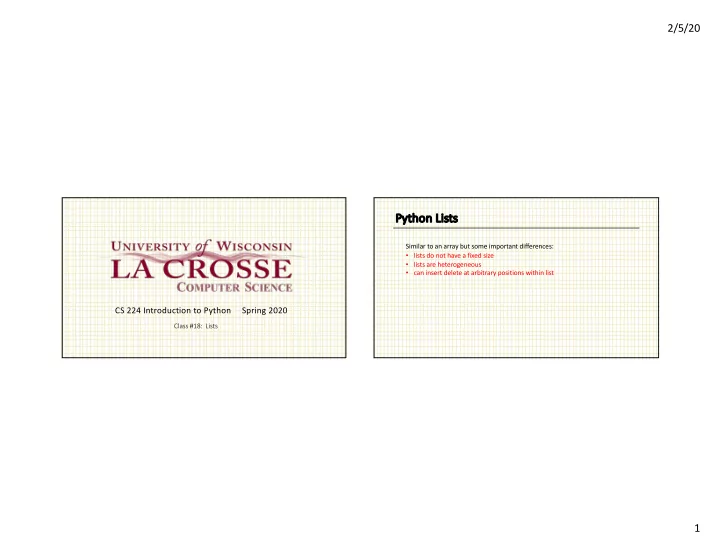

2/5/20 Py Python Lists Similar to an array but some important differences: • lists do not have a fixed size • lists are heterogeneous • can insert delete at arbitrary positions within list CS 224 Introduction to Python Spring 2020 Class #18: Lists 1
2/5/20 Cr Creating a List Ac Accessor my_list = [] # creates an empty list nums = [1, 2, 3, 4, 5, 6, 7, 8, 9, 10] my_list = list() # creates an empty list my_list = [1, 2, 3] # creates a list containing nums[5] # value is 6 # elements 1, 2 and 3 nums[len(nums)-1] # value is 10 list2 = my_list # creates a reference to my_list nums[-1] # value is 10 nums[-2] # value is 9 my_list = [1, 3.14, ‘test’, [‘a’, ‘b’]] # note different types Accessor results in an element s = ‘abc’ my_list = list(s) # creates list [‘a’, ‘b’, ‘c’] 2
2/5/20 Sl Slices List Operations Li nums = [1, 2, 3, 4, 5, 6, 7, 8, 9, 10] • len(my_list) # number of elements • min(my_list) # minimum value nums[3:6]) # value is [4, 5, 6] • max(my_list) # maximum value t = nums[4:] # t is [5, 6, 7, 8, 9, 10] • sum(my_list) # sum of the values u = nums[:7] # u is [1, 2, 3, 4, 5, 6, 7] • all(my_list) # True if all elements True v = nums[-4:] # v is [7, 8, 9, 10] • any(my_list) # True if any element True w = nums[:-5] # w is [1, 2, 3, 4, 5] Slices are lists 3
2/5/20 Mo More List Operations Me Methods to add to a list • my_list[i] = x my_list.append(e) # element assignment • my_list[i:j] = u_list adds element e to end of my_list # replaces slice with # another list # delete i th element • del my_list[i] my_list.extend(u_list) • del my_list[i:j] concatenates u_list onto my_list # delete slice • u_list + v_list my_list.insert(i, e) # concatenate • e in my_list inserts element e at position i # True if e is element in my_list 4
2/5/20 Me Methods to remove from a list Methods to re Me rearrange a lis list my_list.pop([i]) my_list.reverse() returns element at position i and removes it reverses elements of my_list in place. from my_list. if no parameter given, returns last element. my_list.sort() sorts elements of my_list in place. my_list.remove(e) my_list.sort([key, [, reverse]]) searches for e in my_list and removes if found. sorts elements of my_list in place. key if multiple occurrences, removes only one. is a sort-key function. reverse is a optional Boolean flag. 5
2/5/20 Ot Other list methods my_list.count(e) returns number of occurrences of e in my_list. my_list.index(e [, start [, stop]]) returns the smallest index i for which my_list[i] == e. optional parameters start and stop constrain the search. sorted(my_list [, key [, reverse]]) returns a sorted version of my_list but does not change my_list. 6
Recommend
More recommend